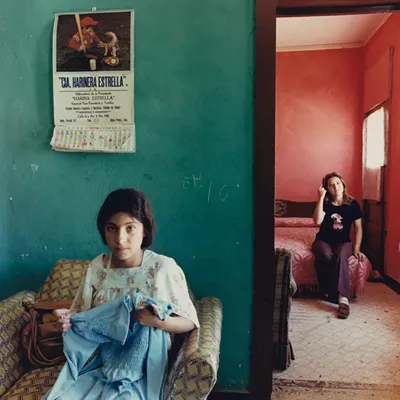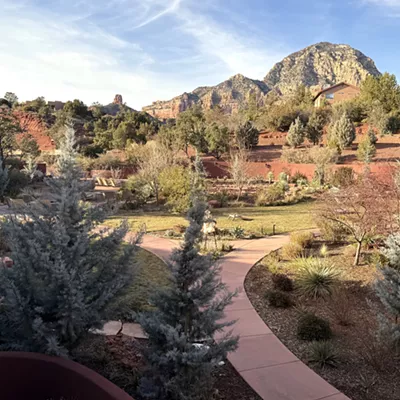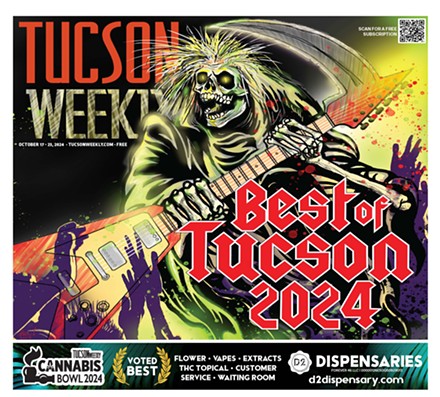On the first beautiful Saturday of fall, with the skies a brilliant blue and the temperature down to a bearable 88, a fiesta unfurled in the sun-and-shade patio behind Mission San Xavier del Bac.
Jacobo Ramirez and his band Tradiciónes were playing in the shadow of the church walls, mixing Mexican fiddle and guitar sounds with haunting Andean pipes. White-haired viejitas were dancing away, swaying their hips to the music with aplomb. A brown-robed Franciscan priest strolled around greeting the guests, and a trio of nuns sat chatting at a table.
The guests, some 75 strong, munched on pan dulce, but the hungriest among them sneaked out to the Tohono O'odham food stands in front of the church, where they gobbled up fry bread and carne asada on freshly made tortillas.
This very Tucson celebration was in honor of—who else?—Big Jim Griffith, the famed folklorist who has made a career of studying the unique blend of cultures in Baja Arizona and Sonora. At 84, he has just published his ninth book, Saints, Statues and Stories: A Folklorist Looks at the Religious Art of Sonora, gleaned from years of travel in the Mexican state that is Arizona's neighbor.
Filled with Griffith's photos of sacred paintings and statues, the book is bursting with tales of saints who have saved a community in danger or even thwarted a village's plan to move a statue to another church.
"What a folklorist sees in these narrative themes, which form the core of the book," Griffith writes, "are patterns of communally held beliefs and values."
Best known around town for founding Tucson Meet Yourself, the wildly popular folklife festival of food and culture, Big Jim is a respected scholar. He has a Ph.D. in both cultural anthropology and in art history, and he's the retired director of the Southwest Folklore Center at the UA.
But Griffith's erudition doesn't keep him from being an entertaining writer or from enjoying the many delights of Sonora. Along the roadways he traveled for the new book, he says, "By stopping, buying, eating and chatting, I gained a much better understanding of the region."
At the party, Griffith oversaw the proceedings with his usual grin, gliding around easily in his electric wheelchair. He talked with each fan who'd waited in a long line to get their books signed, and he laughed at the jokes of his friends and colleagues giving speeches.
His research associate and friend, Francisco "Paco" Javier Manzo Taylor, who traveled the byways of Sonora with Griffith as they worked on the book, regaled the crowd with his own stories of wayward saints and venturing into the fields with Big Jim.
"I had a terrific 15 years working with Paco," Griffith told the audience. "He made the book possible."
In the churches, he recounted, Paco would chat up the church authorities while Griffith poked around and got the photos he wanted. "It was whole lot of fun."
Tom Sheridan, an anthropologist of the borderlands and another Griffith friend, declared to the partygoers that "Tucson is full of Big Jim's cultural DNA."
That DNA is most apparent in Tucson Meet Yourself, which Griffith founded with his wife, Loma Griffith, back in 1974. The beloved three-day folklife festival (motto: Come for the Food. Stay for the Culture) offers up food from locals hailing from nearly every nation under the sun: think Jamaican jerk chicken, Polish potato pancakes, Venezuelan arepas. Its equally vibrant performances range from Filipino dancing to old-time O'odham fiddling. (This year's edition happens this weekend, Oct. 11 to 13.)
Sheridan noted that Griffith also helped launch the Southwest Mission Tour, an important—but fun—tour that takes people to the jewel-box mission churches in northern Sonora and the big church in Magdalena, where Father Eusebio Kino is buried. As Big Jim writes in his book, southern Arizona and northern Sonora, "now split by the U.S.-Mexico border," were "one region in Kino's day."
Among other achievements, Griffith co-founded a national cowboy poetry fest in Nevada, and, back in Tucson, on Oct. 26, his collection of Mayo and Yaqui masks will go on view at the Arizona State Museum.
But Griffith's accomplishments are not confined to the Southwest. In 2011, he won the coveted National Heritage Fellowship, National Endowment for the Arts award, the highest honor in the folk and traditional arts. The same year he also netted the Bess Lomax Hawes prize, for "significant contribution to the preservation and awareness of cultural heritage."
And he's not done yet. Big Jim has a 10th book up his sleeve. His eyes gleaming, he says he's plotting a volume that he hopes will carry on his work. It will teach people without anthropology training "how to do folklore."
Griffith is long retired, and Tucson Meet Yourself in the capable hands of Dr. Maribel Alvarez, who holds the Jim Griffith Chair in Public Folklore (Southwest Center/School of Anthropology) at the UA. Under Alvarez, the festival still exists but it has expanded into the Southwest Folklife Alliance, a year-round operation supports traditional artists through master-apprentice artist awards, offers workshops and tours, and publishes articles on regional folklore.
Alvarez praises Griffith’s work as far ahead of his time.
“Jim has been for Tucson, for more than five decades, a teacher and prophet about simple but deep-cutting truths,” she said.“He knew things before they surfaced in our public consciousness. He upheld cultural diversity and social equity as the core strength of this community decades before these code words entered boardrooms; he recognized downtown Tucson as the civic center of our common story at a time when the city core was neglected by most influential city leaders; he gave us words like ‘foodways’ before UNESCO ever discovered the Old Pueblo; he brought lowriders together with Buddhists monks and old-time fiddlers with Yaqui ceremonial dancers to help illuminate beauty, kinship, and resiliency in ways we never imagined possible.”











